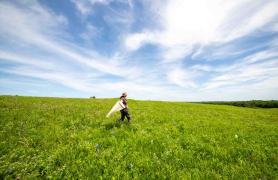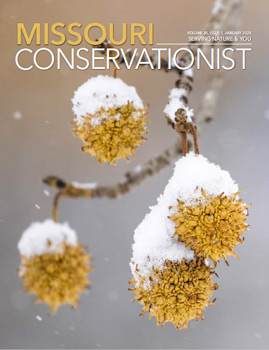Got a question for Ask MDC? Send it to AskMDC@mdc.mo.gov or call 573-522-4115, ext. 3848.
Q: Why does this buck still have fawn-like spots?
As they transition from summer to winter fur, whitetail fawns typically lose their white spots completely during their first molt at three to four months of age, thus acquiring a gray uniform coloration.
In the case of this deer, it already has experienced a few molting cycles. So, it likely has a genetic trait that causes it to continue growing hair with white spots as it replaces its fur, said MDC Private Lands Deer Biologist Kevyn Wiskirchen.
“I’ve heard of this only a few times, so I believe it is very rare,” Wiskirchen said. “We have seen pictures of this deer as an adult for two consecutive years now, each time with the same spot pattern, so I would expect this deer to continue to have visible spots throughout its life.”
Q: What are the best practices for handling leaf litter and garden debris?
More and more conservationists are encouraging homeowners to keep leaf litter and plant debris in place for pollinators to use as shelter throughout the winter. If you are looking to support insect life, an untidy yard is best. Beneficial insects — such as beetles, roly-polies, grasshoppers, and crickets — use the thick layer of leaf litter to overwinter.
The insects that survive winter awaken in the spring and become a valuable source of food for ground-foraging birds, amphibians, reptiles, and small mammals. Without a healthy supply of bugs, many species of native wildlife struggle to survive.
Homeowners can help by allowing leaves to decompose naturally in a less-used corner of their yards. As an added benefit, allowing a discrete pile of leaves to compost naturally can improve the quality of the soil over time, thus making it easier for flower gardens and lawns to flourish. The slow decomposition amends the soil with rich organic matter, which provides food for invertebrates.
A garden that supports life is going to look messier than a sterile garden. One place where it makes sense to clear away autumn leaves and plant debris is in vegetable gardens.
“These crops can be easily overwhelmed by pest species, so treatment is warranted,” said MDC Natural History Biologist Steve Buback. “Overall, we are finding that pollinator diversity in urban areas can easily equal or exceed that of natural systems, and these home plantings can play a large part in supporting that diversity.”
Q: My son harvested this buck, and we are curious about its mane. From the picture, you can see how far down its back it extends, standing approximately 1½ inches tall. We have never seen this, and we haven’t found any taxidermist that has, either. Is there any information from MDC about this?
According to Private Lands Deer Biologist Kevyn Wiskirchen, MDC has received reports of deer with manes like this several times before. So, while this trait is still considered rare, it is more common than the genetic trait of the spotted buck featured in the previous question.
“Just like with the spotted buck, it likely also is genetically linked, perhaps a recessive trait that surfaces every so often,” Wiskirchen said. “It could be a gene that was expressed in a common ancestor of whitetails and elk, for example, and elk still express this characteristic, but whitetails typically do not.”
Not much is known about this trait, Wiskirchen said, but in online forums taxidermists report encountering deer with manes on occasion.
Also In This Issue

Serving Nature and You: Fiscal Year 2023.
And More...
This Issue's Staff
Editor - Angie Daly Morfeld
Associate Editor - Larry Archer
Photography Editor - Cliff White
Staff Writer - Kristie Hilgedick
Staff Writer - Joe Jerek
Staff Writer – Dianne Van Dien
Designer - Shawn Carey
Designer - Marci Porter
Photographer - Noppadol Paothong
Photographer - David Stonner
Circulation – Marcia Hale






















